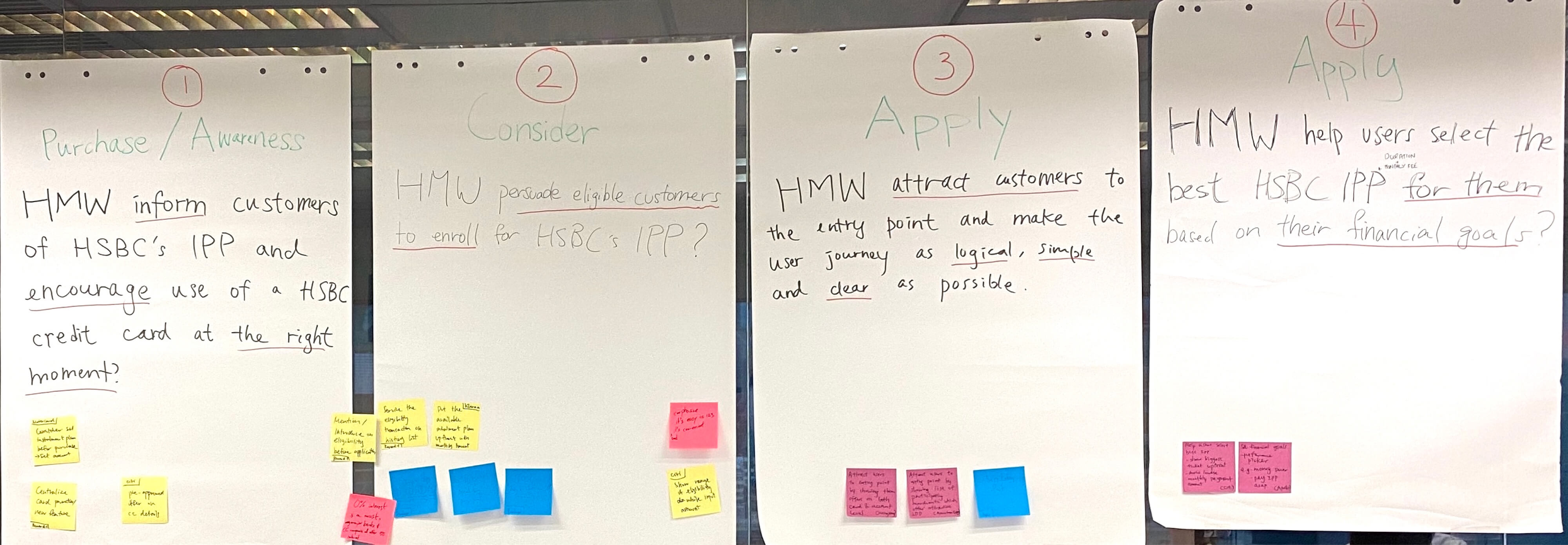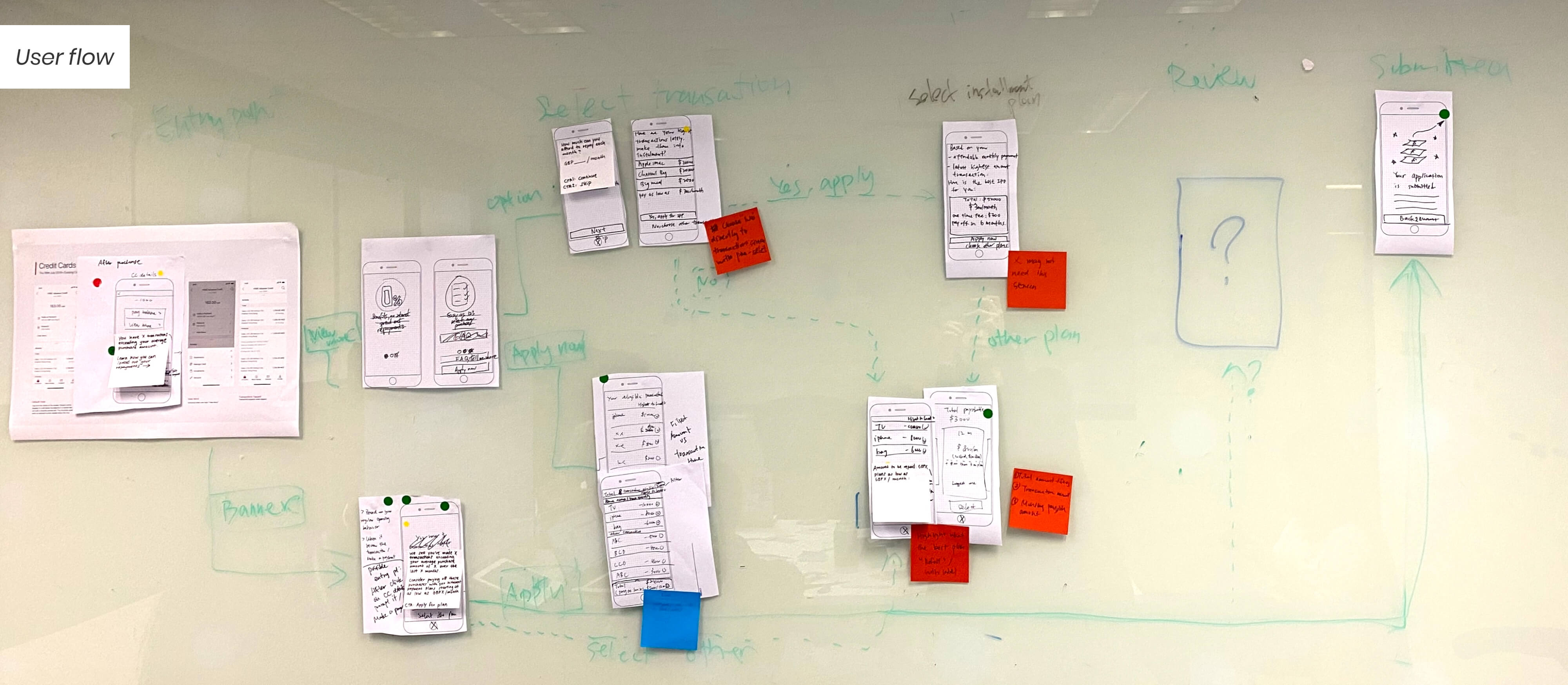
HSBC Design Sprint Case Study
Background
Before starting to work on the design of a credit card instalment product for HSBC, I was lucky enough to participate in a Design Sprint with stakeholders such as the Product Owner, Service Designer and of course my Design teammates. We followed The Design Sprint Kit by Google which includes how to prepare for a Design Sprint and the super detailed phase by phase methodologies. I learned a lot from this Design Sprint, that’s why I wanted to make a case study of it to document the process.
Project
HSBC Design Sprint Case Study
My Role
Product Designer
Scope
Research, User Journey Map, Expert Interviews, “How Might We”, Crazy 8s, Wireframe
Year
2020
The Challenge
This time our target market is the UK. There was a released instalment product in HSBC Singapore but the drop off rate was quite high. So our main focus of the Design Sprint was to improve the overall user experience of the product, as well as to decrease drop off rate and boost conversion rate.

Day 1 - Understand
In the Understand phase, we aimed to create a shared knowledge base across all participants. The goal of the first day is to specify what challenge we’re facing and talk about the problems from business, users, competitors, and technical aspects.
Lightning Talks and Goals Setting
We started with Lighting Talks, the core Design Sprint method and a powerful opportunity to build ownership in the team. Stakeholders were invited to talk about the background information of the product as well as topics that are relevant to our challenge. After the Lightning Talks, we spent some time in setting our goals of the Design Sprint to avoid scope creep and deliver quality over quantity.

User Journey Map
After defining the high-level goals for the Design Sprint, we started to do some exploratory research about Instalment Plan on credit card. The existing user reviews and market research gave us sufficient information to start drawing the User Journey Map, which enables us to show a user’s experience step by step as they interact with our product.

Expert Interviews and “How Might We”
In the afternoon, we conducted Expert Interviews with our Service Designer, she gave us some tips on how to prioritize the needs of different segments of users. And the Product Manager, she articulated the existing problems from business and competitor perspectives. While the experts were sharing, the team wrote down some “How Might We” questions and put them on the map. Afterward, we voted on the most compelling “HMW” opportunities.


Day 2 - Ideate
After the first day of the Design Sprint, everyone got really excited and expected for the second day since that’s the most interesting part - ideation! We started by summarizing the voted “HMW” opportunities on each stage and put related sticky notes on the A2 papers.

Lightning Demos
Before starting to sketch anything, we used Lightning Demos. It encouraged us to research competitors and find examples of existing products that could serve as inspiration for our solution.
Crazy 8s
After presenting the examples, we then moved to Crazy 8s. It’s an excellent Design Sprint method that challenges us to sketch eight distinct ideas in eight minutes. The goal is to push beyond our first idea and to generate a wide variety of solutions. We managed to come up with many awesome ideas in this activity!

By the end of the day, everyone left feedback on the sticky notes and put them on the relevant sketches.


Day 3 - Decide
Based on the feedback we received on Day 2, we decided to spend more time elaborating on the ideas and improving the sketches. Our Service Designer joined us that morning as she is more familiar with how users interact with our product from end to end.

Dot Voting
After presenting the ideas internally, it’s time to invite more stakeholders back to the room and vote for the best solutions! This activity is important as it reminds the team of business problems, goals, and success metrics. More importantly, it's an efficient way to agree and align on which sketches would be put into the prototype.

Day 4 - Prototype
The fourth day of the Design Sprint was devoted to creating the prototype. We started by putting the picked sketches from Day 3 like a user flow on the board. While I and another Product Designer were designing the prototype in Sketch, our Copywriter helped us with providing content for each screen. We managed to put all the selected sketches from dot voting into an InVision prototype. All the team members felt very relieved and fulfilled by the end of the day:)

Day 5 - Test
Since we have got an in-house researcher, after passing the prototype to him he started to prepare the questions for usability testing. HSBC hired a UK based experience design consultancy to carry out the testing for us. In the end, we managed to get valuable feedback from 6 users in the UK, and the usability testing report gave us important insights to improve the design with iteration. Due to NDA, the prototype, questions we asked and the testing result won’t be shared here.
Learning
Our team loved the Design Sprint process. As a Product Designer, I particularly enjoyed it as I got to know so much more about the product. Few things I learned were:
• Getting started is more important than being right - When we are faced with a new project, it can be difficult to figure out how to get started. The Design Sprint offered us specific instructions on how to work as a team and make strategic decisions. Throughout the process, we told each other there's no such thing as a bad idea, that’s how we got many awesome ideas during the ideation phase.
• Design Sprint helped me push my limits - It taught me don’t be afraid to think boldly even there’s a big challenge. Treating those 5 days as a learning opportunity, and having an accountable leader who pushed me to think outside the box was extremely valuable.
• Plan well in advance and invite the right people - People are busy, it's important to plan well and find out what time different stakeholders are available in advance. Getting a sprint team with diverse skills and knowledge also helps decision making and brainstorming.
Without the Design Sprint, we wouldn’t have spent time together in deeply understanding users’ pain points and opportunities for our product. The Design Sprint is a very practical step-by-step process to apply Design Thinking principles in solving problems and pushing our creative limits. I really hope that I can do another Design Sprint again soon!

